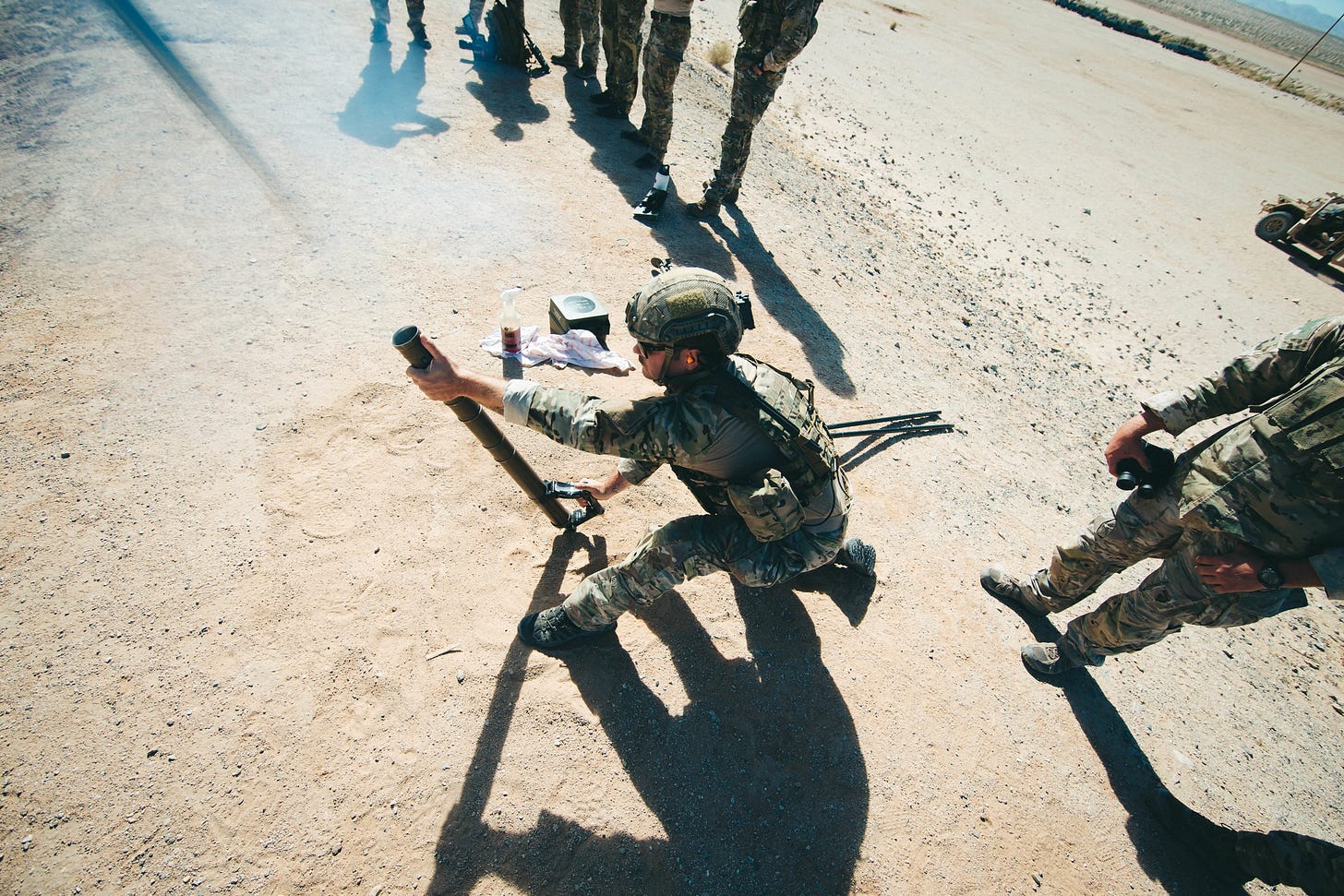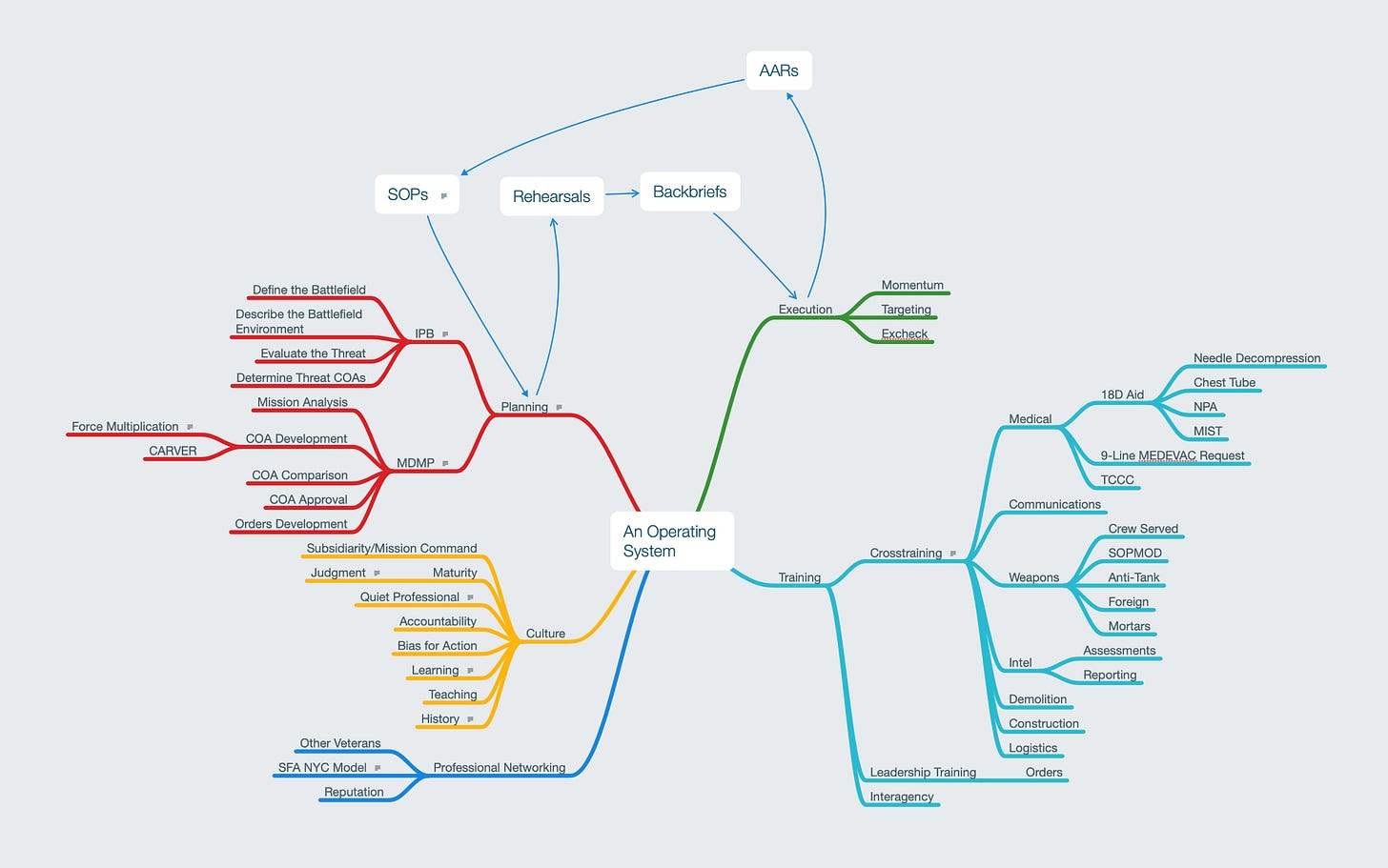Building a Framework: QMN074
Martial Mental Models: The Quartermaster Newsletter, Monday, 23 December
(This week’s report is a 6 minute read)
BLUF: We’ve covered a lot in 2019 with this newsletter, but there’s room for a lot more and I’m sharing the framework so you can see what we’ve looked at, and what might come up in 2020. Hearing about what’s interesting, and useful, and finding out how best to translate it is always an adventure. Is there a concept or other topic you’d like to know more about?

Green Berets with 3rd Special Forces Group (Airborne) fire a M224 60mm mortar system handheld at Twentynine Palms, Calif., Oct. 16, 2019. Photo by Cpl. William Chockey
Brady here. In the past 10 months, KS Anthony and I have published 73 posts on everything from instrument-free land navigation to corporate culture. Our most popular posts have been around emergency medical practices, accountability, Memorial Day, counterinsurgency, a real-world AAR,Rob Shaul’s Quiet Professional ethos, and a very special look at self-discipline in a very bad place. In almost every case the topics of our posts have been a surprise for our readers, so you might be interested to know that there’s a framework to what we’re building. Due primarily to the necessities of unconventional warfare, the span of Green Beret knowledge is great and rarely is there a valuable skill or methodology of warfare that they haven’t tried out. A few of these approaches have really stuck - like MDMP, the Orders Process, and AARs - and I know that if applied appropriately, they are game-changing practices for civilian organizations. I think you’ll notice we’ve covered a lot on the left and not as much on the right - that’s actually something I’d like your feedback on. More below.

QMN Mind Map (via MindNode): Concepts for Discussion
So what have I found? The primary skill needed to write this newsletter, and communicating the value of the concepts above, has been translation. There are some pretty surprising and interesting things in professional military culture and practice that I know a lot of people like learning about, but the now-wide gap in culture, the proliferation of jargon and acronyms, the US military’s regional layout (like where all the big bases are), class stratification and all-volunteer aspects of the US military have made these ideas not only foreign to most Americans, but also difficult to put across from the other side. The most impactful concepts from the past year have been so fundamental to military life that they were difficult to research or in some cases even conceive of as abstract things. Did you know there isn’t a military manual on accountability, or its presence in the culture of an organization? So many people say that its absence in civilian settings is the biggest obstacle to applying military leadership concepts at work (and Extreme Ownership’s success is a testament to this), but it’s a little scary not just how wide the gap has become, but how deep it is as well.
I never know what people are going to like. I like talking about the context of warfare - essentially the history and future of fighting, where we find ourselves today, how we got here, and where we might be in the next few decades, and why. These topics are in a weird place today because while the military history section at your local Barnes And Noble is disproportionately still big and busy, most military history offerings in higher education have disappeared in the past few decades. Even if you’re a general history major in an undergraduate program, you could still get your degree without ever touching the specifics of human conflict. What that means is that the people in civilian society who historically have had some exposure to these concepts (from their time in school) today usually don’t. It’s not a good thing. But I think we can play a role in a remedy.
The truth is that KS and I originally started out thinking we’d look a lot more at tech, and while that comprises still a part of what we do talk about, we’ve been getting the most and best feedback on the explanation of military planning concepts or frameworks, and leadership mindsets or practices. KS and I will be reworking the official focus of the newsletter in the next few months.
So other than address what we’re really looking at, officially, what would I like to do in 2020? It’s mostly about you, actually.
I’d like to cover more of the Operating System Framework above. That’ll mean some dives into Green Beret occupational specialties.
I want to know more about what our readers want to read and what’s useful to them. Do you want to know more about the specialties mentioned above? Which ones?
I want to create a reference tool for our readers, their friends and coworkers to use these concepts in their lives.
I’d like to meet more of our readers. The new conversations I’ve had that’ve come from sharing the content of this newsletter have often been unexpected and always revelatory. I want more of that.
I want to put Rob Shaul’s Quiet Professional ethos into action with some defined practices, and share them.
If you, dear reader, have any insight or feedback on any of the above, please don’t hesitate to contact me directly at https://bradyjmoore.com/contact/.
Finally, KS and I would like to thank those who’ve contributed to this newsletter this year. This includes Kevin Todd, Chris Papasadero, Chris Erickson, Herb Thompson, Pete Wright, and CI Reichel.
Colin Nagy, Noah Brier, and Nick DeWilde have done us a true service by recommending our newsletter to their own readers and we couldn’t appreciate it more. If you’re reading this you likely already read the Why Is This Interesting? and Jungle Gym newsletters, but if you don’t you should. Interacting with the guys has made me realize the value of these concepts and motivates me to uncover and share more.
Thank you for reading and sharing, and keep letting me know the things you want to know about every week.
*****
YOUR WORLD: Alienated, Alone And Angry: What The Digital Revolution Really Did To Us (12 min) “I’ve spent six years reporting on deeply alienated people on the internet, during which time I’ve come to see conditions of disconnection and frustration everywhere the Digital Nation touches: on social media, in search algorithms, in the digital economy. In myself. The feelings of powerlessness, estrangement, loneliness, and anger created or exacerbated by the information age are so general it can be easy to think they are just a state of nature, like an ache that persists until you forget it’s there. But then sometimes it suddenly gets much worse.” (BJM)
POWERFUL GAINS: AI & Robots Crush Foes In Army Wargame (5 min) “Their capabilities were awesome,” said Army Capt. Philip Belanger, a Ranger Regiment and Stryker Brigade veteran who commanded a robot-reinforced platoon in nearly a dozen computer-simulated battles at the Fort Benning’s Maneuver Battle Lab. “We reduced the risk to US forces to zero, basically, and still were able to accomplish the mission.” That mission: dislodge a defending company of infantry, about 120 soldiers, with a single platoon of just 40 attackers on foot. That’s a task that would normally be assigned to a battalion of over 600. In other words, instead of the minimum 3:1 superiority in numbers that military tradition requires for a successful attack, Belanger’s simulated force was outnumbered 1:3. When they ran the scenario without futuristic technologies, using the infantry platoon as it exists today, “that did not go well for us,” Belanger said drily.” (BJM)
THIS IS…NEW: The Generosity of Scars (18 min) “Your darkest struggle can be your greatest gift to those you lead...if you are willing to pay the price. This talk was presented to a local audience at TEDxSantaBarbara, an independent event.” (BJM)
Remarks Complete. Nothing Follows.
KS Anthony (KSA) & Brady Moore (BJM)
